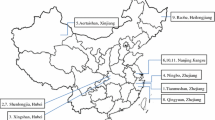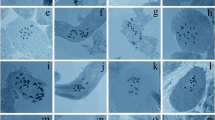Abstract
Karyotypic characters, mitotic metaphase chromosomes, monoploid idiograms and karyograms of Minuartia anatolica (Boiss.) Woronow var. phrygia (Bornm.) McNeill, Minuartia anatolica (Boiss.) Woronow var. scleranthoides (Boiss. & Noe) McNeill, Minuartia corymbulosa (Boiss. & Balansa) McNeill var. gypsophilloides McNeill and Minuartia aksoyi M.Koç & Hamzaoğlu were investigated for the first time. Analysis of somatic metaphases showed that the chromosome numbers and the formulas of these taxa were 2n = 24 = 14m + 6sm + 4st for Minuartia anatolica var. phrygia, 2n = 14 = 6m + 8sm for Minuartia anatolica var. scleranthoides, 2n = 14 = 6m + 4sm + 4st for Minuartia corymbulosa var. gypsophilloides and 2n = 30 = 14m + 10sm + 6st for Minuartia aksoyi. No satellites were observed in the karyotypes of these taxa. Karyotype asymmetry was estimated by many different methods, namely the Stebbins classification, the karyotype asymmetry index (As K %), the total form percent (TF %), the Rec and Syi indices, the intrachromosomal asymmetry index (A1) and interchromosomal asymmetry index (A2), the dispersion index (DI), the degree of asymmetry of karyotype (A index) and the asymmetry index (AI).




Similar content being viewed by others
References
Arano H (1963) Cytological studies in subfamily Carduoideae (Compositae) of Japan. IX. The karyotype analysis and phylogenic considerations on Pertya and Ainsliaea. Bot Mag Tokyo 76:32–39
Bittrich V (1993) Caryophyllaceae. In: Kubitzki K, Rohwer J, Bittrich V (eds) The families and genera of vascular plants, vol 2. Springer Verlag, Berlin, pp 206–236
Cai J, Wang H, Gu ZJ, Mill RT, Li DZ (2004) Karyotypes of thirteen species of Pedicularis (Orobanchaceae) from the Hengduan Mountains region, NW Yunnan, China. Caryologia 57:337–347
Çelebioglu T, Favarger C (1982) Contribution à la cytotaxonomie du genre Minuartia L. (Caryophyllacées) en Turquie et dans quelques régions voisines. Biol Ecol Medit 9:139–160
Çelebioglu T, Favarger C (1983) In IOPB chromosome number reports LXXXI. Taxon 32:666–667
Çelebioglu T, Favarger C (1993) Mediterranean chromosome number reports 3 (125–166). Fl Medit 3:323–333
Davis PH, Tan K, Mill RR (1988) Flora of Turkey and the East Aegean Islands, vol 10; suppl 1 Edinburgh University Press, Edinburgh, pp 67–69
Huziwara Y (1962) Karyotype analysis in some genera of compositae. VIII. further studies on the chromosome of Aster. Am J Bot 49:116–119
Lavania UC, Srivastava S (1999) Quantitative delineation of karyotype variation in Papaver as a measure of phylogenetic differentiation and origin. Curr Sci India 77:429–435
Levan AK, Fredga K, Sandberg AA (1964) Nomenclature for centromic position on chromosomes. Hereditas 52:201–220
McNeill J (1967) Minuartia L. In: Davis PH (ed) Flora of Turkey and the East Aegean Islands, vol 2. Edinburgh University Press, Edinburgh, pp 38–67
Paszko B (2006) A critical review and a new proposal of karyotype asymmetry indices. Plant Syst Evol 258:39–48
Pavlova D, Tosheva A (2005) Notes on karyomorphology of melilotus officinalis populations in Bulgaria. Caryologia 57:151–158
Peruzzi L, Leitch IJ, Caparelli KF (2009) Chromosome diversity and evolution in Liliaceae. Ann Bot London 103:459–475
Romero Zarco C (1986) A new method for estimating karyotype asymmetry. Taxon 35:526–530
Stebbins GL (1971) Chromosomal evolution in higher plants. Edward Arnold, London
Venora G, Blangiforti S, Ruffini Castiglione M, Pignone D, Losavio F, Cremonini R (2002) Chromatin organisation and computer aided karyotyping of Triticum durum Desf. cv Timilia. Caryologia 55:91–98
Watanabe K, Yahara T, Denda T, Kosuge K (1999) Chromosomal evolution in the genus Brachyscome (Asteraceae, Astereae): statistical tests regarding correlation between changes in karyotype and habit using phylogenetic information. J Plant Res 112:145–161
Zuo L, Yuan Q (2011) The difference between the heterogeneity of the centromeric index and intrachromosomal asymmetry. Plant Syst Evol 297:141–145
Acknowledgments
This work was financially supported by the Scientific Research Projects Fund of Bozok University. The project number was I.F.E-2011/50.
Author information
Authors and Affiliations
Corresponding author
Rights and permissions
About this article
Cite this article
Eroğlu, H.E., Şimşek, N., Koç, M. et al. Karyotype analysis of some Minuartia L. (Caryophyllaceae) taxa. Plant Syst Evol 299, 67–73 (2013). https://doi.org/10.1007/s00606-012-0703-8
Received:
Accepted:
Published:
Issue Date:
DOI: https://doi.org/10.1007/s00606-012-0703-8




